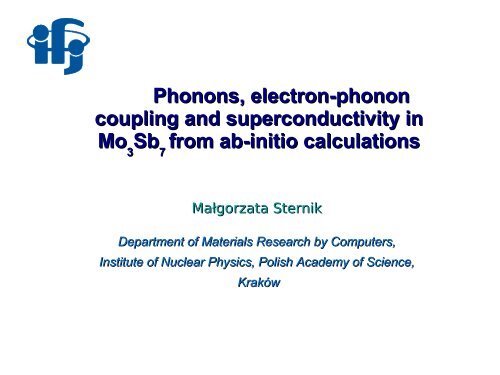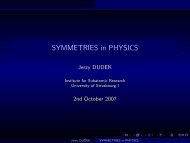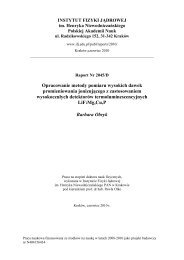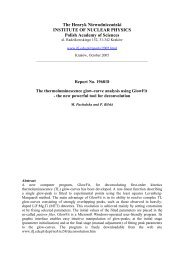Phonons, electron-phonon coupling and superconductivity in Mo Sb ...
Phonons, electron-phonon coupling and superconductivity in Mo Sb ...
Phonons, electron-phonon coupling and superconductivity in Mo Sb ...
You also want an ePaper? Increase the reach of your titles
YUMPU automatically turns print PDFs into web optimized ePapers that Google loves.
<strong>Phonons</strong>, <strong>electron</strong>-<strong>phonon</strong><br />
<strong>coupl<strong>in</strong>g</strong> <strong>and</strong> <strong>superconductivity</strong> <strong>in</strong><br />
<strong>Mo</strong> 3<br />
<strong>Sb</strong> 7<br />
from ab-<strong>in</strong>itio calculations<br />
Małgorzata Sternik<br />
Department of Materials Research by Computers,<br />
Institute of Nuclear Physics, Polish Academy of Science,<br />
Kraków
Superconductivity happens when the charge carriers overcome their<br />
mutual repulsion <strong>and</strong> b<strong>in</strong>d together <strong>in</strong>to Cooper pairs.<br />
In conventional, low-temperature superconductors, <strong>phonon</strong>s - quantized vibrations<br />
of the crystal lattice - are responsible for this pair<strong>in</strong>g.<br />
Hg (1911) ........ MgB 2<br />
(2001) ........<br />
CeCu 2<br />
Si 2<br />
– (1973)<br />
UBe 13<br />
- (1983)<br />
UPt 3<br />
– (1984)<br />
PuCoGa 5<br />
– ( P.Piekarz et al., PRB 72,014521 (2005))<br />
an unconventional mechanism with antiferromagnetic fluctuations<br />
Pair<strong>in</strong>g between fermions can be either <strong>in</strong>duced by <strong>phonon</strong>s, magnons or mediated<br />
by some other boson field.<br />
Experimental arguments that the superconduct<strong>in</strong>g properties are not <strong>in</strong>duced by <strong>phonon</strong>s<br />
●<br />
the quadratic temperature dependence of electrical resistivity<br />
● Fermi energy considerably lower than ħω D
<strong>Mo</strong> 3<br />
<strong>Sb</strong> 7<br />
cubic bcc-structure (space group Im3m)<br />
a = 9.58 A<br />
Z=20 atoms <strong>in</strong> the primitive unit cell<br />
<strong>Mo</strong> (12e) with x=0.3432<br />
<strong>Sb</strong>1 (12d)<br />
<strong>Sb</strong>2 (16f) with x=0.1624<br />
A paramagnetic <strong>in</strong>termetallic compound <strong>Mo</strong> 3<br />
<strong>Sb</strong> 7<br />
is a type II superconductor<br />
with the critical temperature Tc<br />
≃ 2.2 K. (Z.Bukowski, Wrocław – 2002)<br />
The temperature characteristics of the specific heat, the superconduct<strong>in</strong>g gap, <strong>and</strong><br />
the magnetic critical field suggest that the conventional <strong>electron</strong>–<strong>phonon</strong> <strong>in</strong>teraction<br />
might be responsible for the <strong>superconductivity</strong>.<br />
In 2007, C<strong>and</strong>olfi et al. argued that sp<strong>in</strong> fluctuations (SFs) are present <strong>in</strong> <strong>Mo</strong> 3<br />
<strong>Sb</strong> 7<br />
.<br />
This <strong>in</strong>terpretation is supported by two unusual features:<br />
●<br />
the quadratic temperature dependence of both electrical resistivity <strong>and</strong> magnetic<br />
susceptibility, (above Tc)<br />
●<br />
the high value of the susceptibility at room temperature.
to f<strong>in</strong>d an answer, we calculate the T c<br />
us<strong>in</strong>g two formulas:<br />
●<br />
●<br />
What is a mechanism of <strong>superconductivity</strong> <strong>in</strong> <strong>Mo</strong> 3<br />
<strong>Sb</strong> 7<br />
?<br />
<strong>electron</strong>-<strong>phonon</strong> or <strong>electron</strong>-paramagnon <strong>in</strong>teraction<br />
the McMillan formula (<strong>electron</strong>-<strong>phonon</strong> <strong>coupl<strong>in</strong>g</strong> - EPC)<br />
the formula <strong>in</strong>clud<strong>in</strong>g the <strong>in</strong>teraction of <strong>electron</strong> with paramagnons<br />
The <strong>electron</strong>-<strong>phonon</strong> <strong>coupl<strong>in</strong>g</strong><br />
EPC constant - λ ph<br />
The <strong>electron</strong>ic structure – the <strong>electron</strong>ic part of the EPC constant<br />
McMillan-Hopfield parameters η i<br />
The <strong>phonon</strong> dispersion relations – the <strong>phonon</strong> part of the EPC constant<br />
Calculations of <strong>phonon</strong>s<br />
●<br />
Structure – VASP package (G.Kresse)<br />
Density Functional Theory approach<br />
Pseudopotential: <strong>in</strong> the core region - the full-potential projector augmented wave (PAW) method,<br />
valence <strong>electron</strong>s for <strong>Mo</strong> atoms (4p 6 5s 1 4d 5 ) <strong>and</strong> <strong>Sb</strong> atoms (5s 2 5p 3 ) represented by plane<br />
wave expansions.<br />
The structure optimization was f<strong>in</strong>ished when residual forces were less than 10 -5 eV/Å.<br />
The Hellmann-Feynman forces arise when atoms are displaced from their equilirium<br />
positions.<br />
●<br />
Dynamical properties – Phonon software (K.Parl<strong>in</strong>ski)<br />
From the Hellmann-Feynman forces the dynamical matrix is calculated.<br />
The diagonalization of the dynamical matrix provides the <strong>phonon</strong> frequencies <strong>and</strong><br />
polarization vectors.<br />
The number of necessary displacements is determ<strong>in</strong>ed by the symmetry of structure <strong>and</strong> by the number of<br />
nonequivalent atoms.<br />
The value of displacement is chosen to generate the H-F forces larger than computational noise.<br />
The obta<strong>in</strong>ed dispersion relations are accurate when<br />
a supercell sizes are large enough to assure that the force constants fall sufficiently with distance.
<strong>Phonons</strong> <strong>in</strong> <strong>Mo</strong> 3<br />
<strong>Sb</strong> 7<br />
calculated<br />
measured<br />
a(A) 9.64 9.58<br />
<strong>Mo</strong> (0.3421,0,0) (0.3432,0,0)<br />
<strong>Sb</strong>1 (0.25,0,0.5) (0.25,0,0.5)<br />
<strong>Sb</strong>2 (0.1608,0.1608,0.1608) (0.1624,0.1624,0.1624)<br />
M <strong>Mo</strong><br />
= 95.940<br />
M <strong>Sb</strong><br />
= 121.750<br />
three characteristic maxima<br />
of the <strong>phonon</strong> DOS<br />
2.8, 4.4 <strong>and</strong> 6.3 THz
Electronic structure<br />
Korr<strong>in</strong>ga-Kohn-Rostoker (KKR)<br />
multiple scatter<strong>in</strong>g method<br />
Bartłomiej Wiendlocha<br />
Janusz Toboła<br />
Stanisław Kaprzyk<br />
AGH University of Science<br />
<strong>and</strong> Technology, Kraków
the McMillan-Hopfield η i<br />
parameters<br />
EPC constant λ ph<br />
= 0.54<br />
It qualifies <strong>Mo</strong> 3<br />
<strong>Sb</strong> 7<br />
as a medium–<strong>coupl<strong>in</strong>g</strong> superconductor.
The <strong>in</strong>fluence of SFs on the superconduct<strong>in</strong>g critical temperature T c<br />
experimental T c<br />
= 2.2 K for <strong>Mo</strong> 3<br />
<strong>Sb</strong> 7<br />
●<br />
a McMillan-type formula<br />
λ eff<br />
= λ ph<br />
= 0.54<br />
●<br />
the formula <strong>in</strong>clud<strong>in</strong>g the <strong>in</strong>teraction of <strong>electron</strong> with paramagnons<br />
estimated λ sf<br />
= 0.03<br />
The observed magnitude of the superconduct<strong>in</strong>g critical temperature<br />
can be expla<strong>in</strong>ed tak<strong>in</strong>g <strong>in</strong>to account the SF effects,<br />
but the λ sf<br />
parameter has to be relatively small.
Conclusions<br />
Superconductivity <strong>in</strong> <strong>Mo</strong> 3<br />
<strong>Sb</strong> 7<br />
is analyzed us<strong>in</strong>g the comb<strong>in</strong>ed <strong>electron</strong>ic structure<br />
<strong>and</strong> <strong>phonon</strong> calculations.<br />
The <strong>electron</strong>-<strong>phonon</strong> <strong>coupl<strong>in</strong>g</strong> constant λ ph<br />
= 0.54.<br />
This value expla<strong>in</strong>s very well the experimental value of T c<br />
= 2.2 K.<br />
The possible <strong>in</strong>fluence of sp<strong>in</strong> fluctuations on the <strong>superconductivity</strong> <strong>in</strong> <strong>Mo</strong> 3<br />
<strong>Sb</strong> 7<br />
is found to be weak.<br />
B.Wiendlocha, J.Toboła, M.Sternik, S.Kaprzyk, K.Parl<strong>in</strong>ski <strong>and</strong> A.M.Oleś,<br />
Phys. Rev. B 78, 060507 (2008)
Aknowledgment<br />
Krzysztof Parl<strong>in</strong>ski<br />
Andrzej Oleś<br />
Paweł Jochym<br />
Jan Łażewski<br />
Przemek Piekarz<br />
Department of Materials Research<br />
by Computers,<br />
Institute of Nuclear Physics, Kraków<br />
Bartłomiej Wiendlocha<br />
Janusz Toboła<br />
Stanisław Kaprzyk<br />
AGH University of Science<br />
<strong>and</strong> Technology, Kraków
2.9 THz<br />
4.6 THz<br />
6.7 THz<br />
experimental<br />
<strong>phonon</strong> density of states<br />
measured by neutron scatter<strong>in</strong>g<br />
<strong>in</strong> ILL (not published)<br />
This result confirm our prediction<br />
2.8, 4.4 <strong>and</strong> 6.3 THz.

















